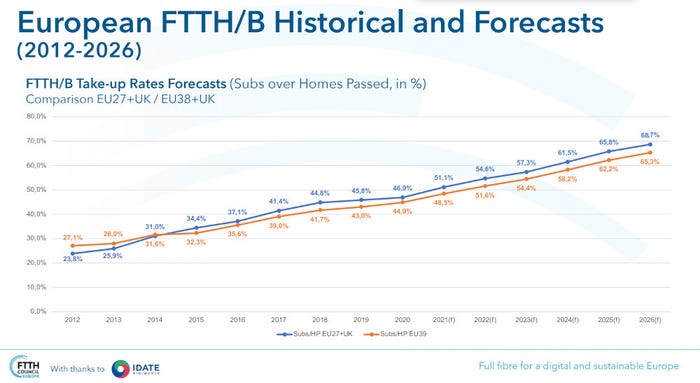FTTH expected to cover 200 million EU homes by 2026
Full fibre will reach close to 200 million premises across core European markets in the next five years, according to new figures shared by the FTTH Council Europe this week.
September 17, 2021

Full fibre will reach close to 200 million premises across core European markets in the next five years, according to new figures shared by the FTTH Council Europe this week.
Fibre-to-the-home or building (FTTH/B) will pass 197 million premises in the EU27+UK by 2026, the firm predicts, using data from IDATE. That’s a hefty increase on the 118 million it forecasts for this year, with growth set to come from some of the region’s major laggards.
“Germany, UK and Italy confirm their huge growth potential and are joined by the Netherlands,” the FTTH Council said in a statement accompanying the numbers.
Indeed, all four nations are predicted to rise up the ranking in terms of both absolute numbers and household penetration. The data suggests Germany will rank second with 33 million homes passed by 2026, putting it above France and behind only Russia. As it stands, Germany ranks seventh with just 9 million homes passed, although given recent developments in the market – Deutsche Telekom is now prioritising fibre rollout having effectively been pushed into it by the altnets – it makes sense that growth is just around the corner.
The pattern in Germany has been mirrored across the continent to one extent or another.
According to the FTTH Council, there are a number of factors behind the increased network deployments, including increased demand triggered by the Covid-19 pandemic, which has itself resulted in considerable growth in private investment. National programmes covering infrastructure and digitalisation are also playing their part, as are the new European digital targets for 2025 and 2030, it explained.
“This trend will be intensified by new usage patterns which are encouraging operators to migrate to FTTH solutions, capable of delivering new services while contributing to the sustainability challenge,” said Vincent Garnier, Director General of the FTTH Council Europe.
“The report shows there is still a massive growth potential in terms of connectivity in many EU countries, but overall deployment is progressing at a rapid pace. However, even with the infrastructure in place, the FTTH Council Europe considers that there is still a long way to go to reach a fully digitised society,” he added. “We strongly believe that to embrace the next digital decade and shape Europe’s digital transformation by 2030, take-up is the next challenge, and we call on policy-makers to take the necessary measures for end-users to benefit from the world of new possibilities offered by full-fibre connectivity.”
The data suggests that customers are starting to get the message on fibre. The analysts forecast a steady increase in uptake through 2026 after a small Covid-induced jump between 2020 and 2021. Take-up will stand at 68.7% in the EU27+UK in 2026, up from a predicted 51.1% this year, and the growth pattern is almost identical across the broader 39 European markets covered by the FTTH Council/IDATE data.

Arguably, the biggest challenge remains the digital divide.
In a separate report the FTTH Council revealed that while over two-thirds of rural households have access to next-generation connectivity, be it FTTH/B, DOCSIS 3.0, VDSL or any technology capable of providing download speeds of 30 Mbps, full fibre plays a fairly small part. FTTH/B coverage stands at 22% of households in rural areas in the EU27+UK, compared with 45% across the territory as a whole.
“The FTTH Council Europe believes that rural areas should benefit from the same services as urban areas and therefore public funds should help bridging this digital divide where private financing is not possible due to the lack of business case,” said Eric Festraets, President of the FTTH Council Europe.
“However to make the most use of public money, only full-fibre projects should qualify for funding as it is the most future-proof and environmentally friendly infrastructure,” Festraets said, unsurprisingly.
Fibre might be the ideal choice, but it’s a bit short-sighted to dismiss the alternatives.
About the Author
You May Also Like












_1.jpg?width=300&auto=webp&quality=80&disable=upscale)
